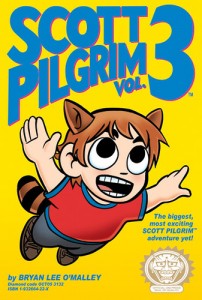Graphic Novel Review – Scott Pilgrim by Bryan Lee O’Malley
Hello. My name is John and I’m a male comic book fan from Toronto.... and, um, I don’t really like the Scott Pilgrim series of graphic novels.
I know, that’s total heresy to some people, but it’s true. I do not enjoy the series. Although I enjoyed the film starring local hipster hunk Michael Cera, I just can’t get into the graphic novels, try as I might. They’re just not my bag.
For the uninitiated: Scott Pilgrim is about the blossoming relationship between the titular hero and his American sweetheart Ramona Flowers. To win the day and the girl, all Scott needs to do is get a job, mature as a person and, oh yeah, defeat her seven evil exes in fights to the death.
The books are heavily influenced by anime, comic books and especially video games. Scott’s band is called “Sex Bob-omb”, combining Tom Jones with one of the more obscure villains from the Super Mario games. There’s a lot to like in that concept, but it just never clicked for me.
This isn’t about going against the grain either. I’m not saying I dislike it just to fly in the face of indy scenesters everywhere. I was actually on board with the series pretty early on. In fact, when I was in undergrad I worked at a very large bookstore in downtown Toronto one of my co-workers was wild about Scott Pilgrim.
When she learned that I was a fellow comic book nerd she insisted I catch up on the series - at that point only three of the six books had come out – and so I dutifully bought the first volume (Scott Pilgrim’s Previous Little Life) and demolished it in about 30 minutes of dock-side reading at a cottage.
There was certainly a lot to like about the book. It had its funny moments, particularly the climactic battle with Matthew Patel, and the characters had some charm. As a young man in Toronto working in a mind-numbing retail job, I had some sympathy for Scott.
Unfortunately, it was also crowded with too many of Scott’s friends and peers, and O’Malley’s artwork wasn’t sophisticated enough to make it clear who was who. Characters bled together on the page and in my mind.
Also, although I could I identify with some aspects of his life, Scott is the kind of person I’ve got little patience for in real life. He’s directionless, insensitive and oblivious to his surroundings. His friends are huffy and prone to inexplicable bouts of anger while hating their dead-end jobs.
If they were real people, I’d go out of my way to avoid them.
So after that first book I gave up on the series and moved on. When inevitably confronted by a hysteric Pilgrim-fan - they are legion in Toronto’s Annex neighbourhood - I’d politely shy away from the subject and explain I was really behind on my reading.
But the film trailers grabbed my attention and I went to see the Edgar Wright-directed movie on opening weekend. After all, it’s a movie that prominently features my hometown and I’m a sucker for all things Toronto.
It was smart, fun and moved quickly. The acting, particularly Cera in the title role and Kieran Culkin as his roommate Wallace Wells, was sharp and witty. I loved it.
That experience, coupled with reports from many friends that the art and writing improved with each book made me think I should give the series a second chance. I borrowed the remaining volumes from the library -Wychwood Branch, a prominent location in the series - and see if the books could redeem themselves.
Well, they didn’t. I still didn’t really like any of the books.
Although I got a better handle on who all the characters were, many were still incredibly whiny. There were too many throwaway scenes, too many pages of Scott lying around on his couch in a sulk. Characters fly into rages for no apparent reason, storming off dramatically to prove their invisble point.
I hated that kind of histrionics when I was in my early 20s, and I’m not keen to re-live it in graphic novel form.
Don’t get me wrong, there are some positives in these books. As far as a coming-of-age story, Scott Pilgrim is very good. There is a real sense of maturation in our hero and he really does develop into a more sensitive and thoughtful person. His complex relationship with Ramona is handled by O’Malley with a deft touch and there is much to be learned from both of them.
The books are also occasionally entertaining. There are pages and scenes that are legitimately funny and seeing stores, restaurants and clubs that I’m intimately familiar with printed on the page never really got old. But all that isn’t enough to overcome some of the deep flaws in this series.
Bryan Lee O’Malley’s Scott Pilgrim series is a fine entry point to the world of graphic novels, but there are at least a dozen other books that a neophyte fan could start with that would be more satisfying. It’s probably best to just watch the Michael Cera movie and then seek out recommendations that are like the books.
Book Review – The Glass Castle by Jeannette Walls
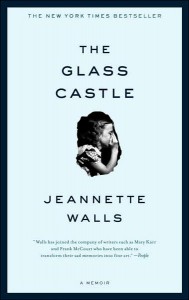 I never thought that I’d enjoy Jeannette Walls’ the Glass Castle, but I was wrong.
I never thought that I’d enjoy Jeannette Walls’ the Glass Castle, but I was wrong.
On the surface, it looked like it was more for stay-at-home moms. It was one of Heather’s Picks at Chapters-Indigo Bookstores and reeked of Oprah’s Book Club. But once I started reading it I appreciated Walls’ writing and was moved by her story.
Like Frank McCourt’s ultra-popular Angela’s Ashes, the Glass Castle is a dark memoir about a dysfunctional family crippled by the father’s alcoholism and the mother’s loose grip on reality.
The Glass Castle also follows a very similar format to Angela’s Ashes with each short chapter detailing an episode from the childhood of the author. More often than not these are horrible snapshots of poverty or struggle as the Walls’ household disintegrates.
These grim anecdotes are broken up by some funny stories from Jeannette’s childhood and the reader is buoyed up by the loyalty of her three siblings as they try to support each other and overcome their parents’ shoddy upbringing.
Walls’ writing is very good and although the subject matter is depressing and unsettling, she wisely injects some humour to create some balance.
What interested me the most was the social dynamics within the Walls household. Jeannette and her three siblings all independently come to the conclusion that their parents are unfit to raise them and that they need to take matters into their own hands.
Writing a compelling memoir is difficult. I’ve read many autobiographies that tell the author’s life story chronologically and from a single perspective. That’s a totally fair and natural way to structure a narrative, especially since an omniscient narrator would be some trick, but it’s obviously also quite limiting.
But Walls – a long-time journalist and former blogger with MSNBC.com – does well to flesh out the “characters” of her family and imply the feelings and motivations of each relative. This adds depth to her story that most autobiographies lack. The way her parents and sibling handles each situation is unquestionably real.
Walls is also a reasonably fair and balanced narrator. Her family might not be thrilled with their personal histories being exposed, but it’d be hard for any member of the Walls clan to say that Jeannette did them a disservice. She lets their actions speak for themselves and rarely puts words in their mouths.
Normally I would dismiss the Glass Castle out of hand. But Walls’ incredible storytelling abilities and the devastating circumstances of her childhood make this memoir a must-read for any fan of literature.
Public funding of stadiums should come with a caveat
David Asper made an articulate argument for the public funding of stadiums in today’s National Post, that focused on sport’s role in culture and how athletics should be treated as the equal of art and drama.
Asper, a guest contributor to the Post, is a law professor at the University of Manitoba as well as a successful businessman who is spearheading the movement for a new community-owned football stadium in Winnipeg.
However, Asper’s argument is framed in the context of the proposed hockey arena in Quebec City that would help bring the National Hockey League back to the capital of la Belle Provence. His article supports Prime Minister Stephen Harper’s recent declaration that the federal government would consider aiding the project.
“Governments at all levels in Canada have an easy time providing billions of dollars annually toward artists and their cultural organizations — many of which are just as ‘professional’ as NHL athletes and teams,” writes Asper.
“Similarly, governments often have little or no problem funding concert halls, theatres, art galleries and other bricks-and-mortar venues where cultural events are performed.”
Although Asper’s clearly got a bit of a bias, he makes a compelling argument. There’s no denying that sport is a part of culture and that all levels of government support artistic enterprises in the name of improving society and contributing to Canada’s collective heritage.
Of course, Asper is conveniently forgetting the fact that the Harper government controversially cut back support to the arts not so long ago and that although there are some musicians, filmmakers and artists who make a healthy living, there are just as many who do not. Professional sports, particularly an NHL franchise in Canada, would be a different animal.
Despite that glaring flaw in his article, it is undeniable that Asper has a point – sport is certainly a worthwhile investment for all levels of government, not just for cultural reasons but also because it encourages healthier lifestyles in citizens.
But those financially allotments should always come with community-oriented strings attached.
These projects shouldn’t just be about generating tourist income and a sense of civic pride – they should also be used to create facilities and programs that can be shared by the public and to encourage athletics at the amateur and recreational levels.
For example, the City of Toronto did well when they agreed to support the creation of BMO Field on the condition that its soccer pitch would also be used for local recreational leagues.
Unfortunately, Toronto City Council’s lawyers didn’t read the fine print just right and Maple Leaf Sports and Entertainment blocked the oft-discussed possibility of moving the Argonauts to BMO Field.
But the stadium is used for recreational soccer leagues and has turned the Canadian National Exhibition Grounds into a hub of activity year-round. The city also got the added bonus of having MLSE, along with the Toronto Nationals of Major League Lacrosse, rehabilitate Lamport Stadium, revitalizing a wreck of a facility that is also being used for amateur sports.
That is how governmental sponsorship of stadiums, arenas and professional sports can pay off - by insuring that these professional teams partner with their local communities to implement athletic programs that will grow sports at the grassroots level. It engages the community, creates fans and helps to develop a unified civic culture.
Research makes perfect
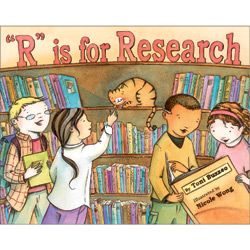 I’ll be the first to admit that I’m a rookie at this professional writing game. Indeed, if there’s one thing I’ve learned in my past year with the Canadian Press, it’s that I don’t know how much I don’t know.
I’ll be the first to admit that I’m a rookie at this professional writing game. Indeed, if there’s one thing I’ve learned in my past year with the Canadian Press, it’s that I don’t know how much I don’t know.
Sure, as a young Canadian male I’d watched more hockey than the average person. But there’s no way I’ve seen as much hockey as some of the big name experts like TSN’s Bob McKenzie and Darren Dreger of the CBC’s Scott Morrison, Don Cherry and Ron MacLean.
No, I definitely still have a lot to learn about the game and the sports journalism business in general.
The only acceptable recourse is to keep striving by working at my craft and doing research to broaden my knowledge base.
This is actually a personal belief that I’ve held for a long time. In fact, last month I was asked to speak to the current cohort at Centennial College, my sports journalism alma mater, and I made a point of talking about the importance of continuing the learning process even after school is done.
After all, sports journalists are required to interview athletes and coaches who have dedicated their whole lives to their sport. They know it inside and out. If we want to engage them and extract thoughtful quotes from them, we need to know what we’re talking about.
That’s one of the many reasons I decided to go to the World Hockey Summit. It was the ideal place to meet with hockey people at the grassroots level and learn about the issues facing the sport today. As you can tell from my four-day diary of the conference, it was an incredibly educational experience.
As I announced yesterday on my Twitter feed the Canadian Press has brought me back for another year as their junior hockey editorial assistant, and so I’m getting down to some serious research.
I’ve begun an email-writing campaign, introducing myself to all the media relations people of the Canadian Hockey League.
Whether it’s the head office here in Toronto, the regional offices of the Quebec Major Junior Hockey League and the Western Hockey League or the teams from Sydney, Nova Scotia to Prince George, British Columbia, everyone has or will hear from me.
The idea is to discover the stories behind each organization. Many of them have already sent me their media guides or are putting me on their mailing lists. Hopefully, these contacts and these press kits will help me come up with more and better feature stories and add further colour to my game stories.
Already I’ve benefitted from this initiative – this morning I was invited to listen in on the QMJHL’s season-opening press conference.
Amongst other pieces of news, league president Gilles Courteau explained that there is a gentleman’s agreement between the AHL and the Quebec-based association to not spread into New England. I was live Tweeting the call and when I mentioned that tidbit I got a big reaction from many followers.
I’m sure that all this work, all this research, will bear more fruit, I’m just not sure how. After all, I don’t know how much I don’t know. But that’s why I’m doing all this research – to try and improve myself as a journalist.
It’s time for a Women’s National Hockey League
 During the final day of the World Hockey Summit it became abundantly clear that Hockey Canada, USA Hockey and especially the National Hockey League need to become more proactive in the growth of women’s hockey.
During the final day of the World Hockey Summit it became abundantly clear that Hockey Canada, USA Hockey and especially the National Hockey League need to become more proactive in the growth of women’s hockey.
It’s something that has been at the back of my mind since the Winter Olympics in Vancouver last February – how can an exciting game like women’s hockey only really be seen on TV every four years? What can be done?
Outside of the collegiate game in the United States and Canada there is no forum for elite women’s hockey. Even at the amateur level there are many municipalities that don’t have leagues for female players, and at the World Hockey Summit there were stories of towns that won’t let women use the arenas, period.
Further, there is no junior hockey for ladies - although women are allowed to play in the three leagues that comprise the Canadian Hockey League.
At the professional level there have been several attempts at running leagues, including the Canadian Women’s Hockey League that has teams in Montreal, Mississauga, Burlington, Brampton, Vaughn and Ottawa.
The CWHL competes for the Clarkson Cup against teams from the Western Women’s Hockey League. The WWHL has franchises in Calgary, Edmonton, Winnipeg, Strathmore and Minnesota.
Although I admire these leagues ambitions, they’re unstable with teams folding or relocating constantly. Other leagues like them have collapsed under the financial and administrative strains of running a professional association.
This is where the NHL needs to step in, and form a WNHL, much like the National Basketball Association’s WNBA, to market and promote a high-calibre female version of hockey.
Like the WNBA model, all the teams could be owned by the NHL or its franchises at first, and as they become more solvent be sold to third parties. Every team would be associated with an NHL or American Hockey League franchise to guarantee cheaper access to facilities and to enable cross promotion.
It would be an easy sell to have a NHL/WNHL double-bill in several traditional hockey markets like the Original Six, in the six Canadian NHL cities and a few other hotbeds like Minneapolis.
Further, when I threw it out to my Twitter followers last week, reader @katylalonde pointed out that there are several locations begging for hockey like Winnipeg, Kitchener, Hamilton and Quebec City. It would be a smart move for all four municipalities to invite a WNHL franchise to their rinks and prove that their arenas are viable venues for professional hockey.
Of course, such an initiative would have to be supported at the amateur level. Hockey Canada, USA Hockey and regional associations would need to do more to promote the women’s game at the amateur level. But with professionals serving as role models, it shouldn’t be too hard.
This is the kind of program that is prime for implementation - all it would takes is a motivated NHL willing to capture the interest of a whole new market of hockey fans.
World Hockey Summit – Day 4
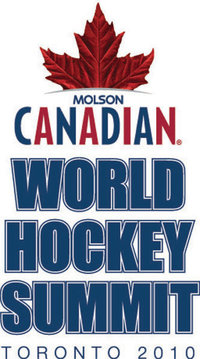 The fourth and final day of the 2010 World Hockey Summit focused on moving hockey forward and continuing to spread the good word about Canada’s favourite sport.
The fourth and final day of the 2010 World Hockey Summit focused on moving hockey forward and continuing to spread the good word about Canada’s favourite sport.
After an early breakfast the conference met in the Toronto Sheraton’s downstairs hall to listen to players, coaches and organizers speak about the movement to promote women’s hockey.
Like the previous day’s sessions on the Olympics and a World Hockey Agenda, all the members of the panel acknowledged that the 2010 Vancouver Games had done wonders for their sports’ public profile.
However, unlike Wednesday’s slanging match, keynote speaker Hayley Wickenheiser and the panel of Mel Davidson, Mark Johnson, Arto Sieppi, Angela Ruggiero and Peter Elander all agreed that women’s hockey had to return to the Olympics as well as stage more international and even professional matches.
Ruggiero made an important point about high calibre women’s play: as a member of Team USA she plays, on average, ten games per year. That’s it.
Once a player graduates from the NCAA, there is no viable professional women’s league. An individual looking to improve their game beyond the confines of a varsity program has to arrange her own ice time and practicemates, a surprisingly difficult task.
This lead to a lengthy discussion amongst the panel, and later amongst the break-out groups, about how to go about creating a professional women’s league that would allow elite female players to hone their skill and provide aspiring hockey players with ready-made heroes.
Promoting hockey to women dovetailed perfectly with the afternoon’s session on Growing Participation in hockey.
Tommy Boustedt of Sweden, Sieppi (again) of Finland, Scott Smith of Hockey Canada and Pat Kelleher of USA Hockey all discussed the particular challenges of promoting hockey in their respective countries.
Both Sweden and Finland focus on education of coaches, players and parents through intensive hockey schools open to all amateur players, while USA Hockey is concerned with branching out past the Three Ms: Michigan, Massachusetts and Minnesota.
Canada, of course, doesn’t have to worry about popularizing the game or breaking into new markets. Instead, their focus is on developing accessibility for low-income families and New Canadians as well as promoting women’s and sledge hockey.
Dr. Paul Dennis of the Canadian Hockey League, Cyril Leeder of the Ottawa Senators and John McDonough of the Chicago Blackhawks also contributed by addressing how their organizations interact with local communities to promote hockey and win over new fans to the game.
Although it was the least exciting of the presentations, that final session served as a fitting end to four days of hockey talk. It put a positive spin on the Summit and insured that the hundreds of delegates would be energized to go out and continue their hard work.
World Hockey Summit: Day 3
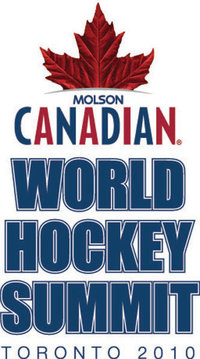 Debate over the National Hockey League’s role in international hockey, especially the Winter Olympics, built to a crescendo at the World Hockey Summit yesterday.
Debate over the National Hockey League’s role in international hockey, especially the Winter Olympics, built to a crescendo at the World Hockey Summit yesterday.
International Ice Hockey Federation President Rene Fasel had started thumping the war drums on Tuesday when he warned the NHL that they would expand to Europe “over his dead body”.
During that same question and answer session with TSN’s Gord Miller he called for professional hockey players to play at the 2014 Winter Olympics at Sochi, Russia.
Wednesday morning there was an evaluation of the 2010 Olympics, with Fasel, Vancouver Organizing Committee CEO John Furlong and International OIympic Committee member Timo Lumme speaking about the great success and popularity of hockey at this year's Games.
All three emphasized that the 114 million worldwide viewers of the USA-Canada men’s hockey final had been drawn, in part, by the fact that it was a best-on-best game that featured NHLers.
After the keynotes were done, Miller, acting as moderator, allowed IIHF member Igor Kuperman, sports marketing guru Brian Cooper, Detroit Red Wings general manager Ken Holland, Ottawa Senators captain Daniel Alfredsson and New Jersey Devils captain Jamie Langenbrunner to respond.
Not surprisingly, all five panellists supported the NHL’s return to the Olympics, with only Holland showing any kind of hesitation. The successful GM had many concerns about scheduling and injury issues affecting the success and health of his professional club.
When discussion broke out amongst the hundreds of delegates in attendance, there was an easy consensus that the NHL and Olympics need each other for the fans and the good of the game.
After lunch, NHL Commissioner Gary Bettman had a Q+A with TSN’s Pierre Maguire. During the interview Bettman repeatedly said there were pros and cons to sending his players to Sochi.
“We haven’t said ‘no,’” said Bettman. “And anybody who suggests that we’ve made a decision or suggests I’m anti-Olympics doesn’t get it, because what we’ve been simply saying is, ‘it’s a mixed bag.’”
Bettman stressed that he was commissioner when the NHL first started playing in the Olympics at Nagano, Japan, four cycles ago and that he has always been interested in exposing the sport to as many people as possible.
Many had expected that Bettman’s half-hour session was going to be the most heated event of the day. However, it was the follow-up discussion of a Global Event Agenda that was really contentious.
Moderated by Darren Dreger, the panel began with a thoughtful presentation by Edmonton Oilers associate coach Ralph Krueger, who had served as head coach of the Swiss national team at the Vancouver Olympics.
Krueger proposed a new schedule for international events, featuring the Olympics every four years, a World Hockey Championship during the intervening years and an under-23 world championship during Olympic years.
He also suggested that the Victoria Cup, an annual club championship between two European teams and two NHL teams, should be revived.
Miller then opened the floor to the panel of NHL Deputy Commissioner Bill Daly, Kontinental Hockey League President Alexander Medvedev, Team USA and Toronto Maple Leafs GM Brian Burke, NHL alum Anders Hedberg, former NHL goaltender and prominent NHLPA member Glenn Healy, NHLPA representative Mike Ouellet and IIHF member and broadcaster Paul Romanuk.
Although things began reasonably as each panellist said their piece, Fireworks ensued when they had the chance to rebut each other.
Generally speaking, Burke and Daly presented the case for the NHL staying out of the Olympics, highlighting that it put teams’ assets – the players – at considerable risk of injury. They were also concerned that the interruption in the professional season damaged the momentum of small-market teams.
“The Olympics don’t hurt the Toronto Maple Leafs, it doesn’t hurt our business model,” said Burke, the former GM of the Mighty Ducks. “But in Anaheim it does. In Nashville, it does. In Florida, it does.”
They were opposed by Healy and Ouellet, who as representatives of the players’ association, felt that their constituency should be allowed to play when and where they wanted, and that practically all NHLers would love to play at the Olympics.
Panellists outside of the labour politics of the NHL like Medvedev, Hedberg and Romanuk also chimed in with their concerns, although all three were adamant that the Olympics should be a “best-on-best” tournament.
The debate laid bare many of the tensions at the highest levels of hockey.
Everything from the ongoing labour disputes between the NHL and NHLPA, the lack of communication between the NHL and IIHF, the competing styles and values of European and North American hockey as well as the emergence of the KHL as a threat to NHL supremacy were all on display.
There were many dramatic moments, including Healy wondering aloud why Burke cared so much about when the World Hockey Championships were scheduled, since the Maple Leafs are always available when the tournament begins in April.
Alliances also shifted quickly in the swirling debate. When a doctor from the IIHF spoke from the floor to correct Healy’s impression that the quality of medical care provided at the Olympics is sub-par, the former Toronto goaltender saw his nemesis Burke leap to his defence.
Similarly, when another delegate called out Burke and Daly saying that it was a simple issue and that he was sick of hearing excuses about NHLers playing in the Olympics, Ouellet and Healy both allowed that it was a complex issue.
Burke was the most energetic debater throughout, taking on all comers from the stage and the floor of delegates, although Daly, Ouellet and Healy were very active as well. It was an exciting and intriguing show that had delegates buzzing for the rest of the day.
Today’s topics will be Women’s Hockey in the morning and Growing Participation. It’s hard to imagine that those panels will be nearly as heated, but you never know.
World Hockey Summit: Day 2
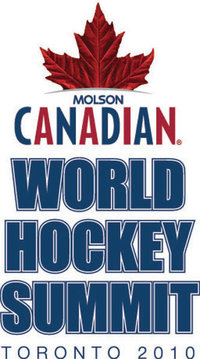 After nine hours of panels, group work, questions and answer periods as well as informal discussions over food, one thing is clear at the 2010 World Hockey Summit: the amateur hockey system has to change.
After nine hours of panels, group work, questions and answer periods as well as informal discussions over food, one thing is clear at the 2010 World Hockey Summit: the amateur hockey system has to change.
Whether it was cautions from Dr. Steve Norris or Dr. Mark Aubry on the overly demanding training in youth hockey during the morning’s Player Skills Development session or the dire warnings of Czech National Program Director Slavomir Lerner of the talent drain from Europe to North America, it was plain as day that things need to change.
Although it’s difficult to sum up nearly six hours of presentations, the general consensus was that minor hockey associations are too focused on turning young players into National Hockey League superstars, sapping the game of its fun and making it excessively dangerous.
As panellist Brendan Shanahan said “How come I don’t hear about kids playing shinny anymore?”
The speakers spoke of multiple concussions to eight and ten year-olds, massive dropout rates in children’s hockey (44% of American hockey players have stopped playing by the age of nine) and a dwindling European junior system robbed of its best talent by the superior Canadian Hockey League.
During question and answer periods as well as in break-out discussion groups the delegates and officials in attendance at the WHS brainstormed ideas that could make amateur hockey fun again for the casual player, while creating a more practical Long Term Athlete Development plan for adolescents and teenagers who want to become professionals.
The idea that was most popular – garnering a round of applause from the Air Canada Centre’s floor when it was suggested – was raising draft eligibility from 18 to 19.
Many groups of delegates had come up with similar concepts including raising the draft age to 20 or forcing players to stay in midget for a minimum of two years and junior for three. A freeze on all international movement at the junior level was also a common theme.
One radical suggestion was to raise draft eligibility to 19, but allow NHL teams to take 18-year-old players at the cost of two draft picks. So a Sidney Crosby-type player would have cost the Pittsburgh Penguins their first and second-round draft picks.
It was an informative and exciting day of hockey talks, and I’d strongly recommend that you follow the above links to see video of the panel discussions. Also, if you want up-to-date quotes from the day’s events follow me on Twitter.
Today’s discussions will start with an evaluation of hockey’s role at the 2010 Vancouver Olympics, then a Q and A with NHL commissioner Gary Bettman and then finish off with an afternoon session on Establishing a Long-Term Global Event Agenda.
World Hockey Summit: Day 1
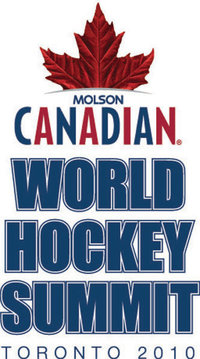 As I mentioned on my Twitter feed, I will be attending the 2010 World Hockey Summit this week, with lots of LiveTweeting on my feed and daily blog posts summarizing what I’ve learned.
As I mentioned on my Twitter feed, I will be attending the 2010 World Hockey Summit this week, with lots of LiveTweeting on my feed and daily blog posts summarizing what I’ve learned.
Hockey Canada is organizing the conference, bringing together hockey organizers, players and coaches from around the world to discuss the future of the game and improve on safety.
In the words of Hockey Canada President Bob Nicholson, the Summit will “provide an inclusive forum to table the most pressing questions surrounding our game and work together to find implementable solutions.”
Day 1 was very straightforward. It was basically clear from nine until five, giving all the attendees a chance to register and settle into their accommodations in downtown Toronto.
Tonight there will be a Hot Stove Session at the Hockey Hall of Fame where four panels rotate from room to room, discussing Contracts and Transfers, Agents’ Role in Working with Young Players, State of the Game and Comparisons of the International and North American Game.
Unfortunately, I’ve got previous commitments for tonight, so I’ll be missing out on those talks. They do sound very interesting though, and I’ll try to get my hands on a recap of the discussions to share here.
Tomorrow will start with a continental breakfast at the Air Canada Centre, home of the Toronto Maple Leafs and the National Hockey League’s Canadian office. There’ll then be a three hour session on Player Skills Development.
At one in the afternoon, Rene Fasel, the President of the International Ice Hockey Federation, is going to have a half-hour Q+A period.
Next up is the session that I am most interested in: Junior Development in the Hockey World. The reason is fairly obvious – as junior hockey editorial assistant for the Canadian Press, this is my wheelhouse.
It’s going to be a lot of fun and interesting week. Please, check back here tomorrow night or my Twitter feed throughout the day to see what it’s all about.
At long last, MMA has arrived in Ontario
 It took a couple of reversals, but Premier Dalton McGuinty has finally made the right decision and ruled that professional mixed martial arts fights can be held in Ontario, paving the way for a lucrative Ultimate Fighting Championship card in Toronto sometime in 2011.
It took a couple of reversals, but Premier Dalton McGuinty has finally made the right decision and ruled that professional mixed martial arts fights can be held in Ontario, paving the way for a lucrative Ultimate Fighting Championship card in Toronto sometime in 2011.
I’ve long supported this move, including a lengthy blog post in February after McGuinty said that the ban on MMA was not going to be lifted.
But now that the Premier has changed his mind, it’s worth repeating some of the arguments in favour of the emerging sport.
As most proponents of MMA have argued, it’s actually the safest of the combat sports because the referees have more discretion to stop the match and as a result are more proactive in ending lopsided bouts.
As a result, unlike boxing’s standing counts, once a fighter has sustained a serious blow to the head, the match is over. This prevents concussions and long-term brain damage.
Old school sports commentators often complain about the blood and savagery of the sport, while championing traditional combat sports like boxing, wrestling, judo and tae kwon do.
This is a weak argument on their part. After all, MMA incorporates strategy and training from all of those disciplines. There’s no case to be made against the submission moves of the UFC when wrestling, one of the world’s first Olympic sports, relies on many of the same moves.
Further, prizefights were already being held on some Native reserves. Legalization province-wide would mean that better, more expansive safety regulations would be created, insuring that mixed martial artists would be guaranteed higher safety standards.
There is also the economic benefit. Toronto is a sporting city and the home base for almost all of Canada’s major media outlets. A major MMA event here would expose the sport to even more people and create a buzz around the industry.
In their press releases the Ontario government has estimated that it’ll generate approximately $6 million for Toronto-area businesses.
I’m no economist and I don’t know how these estimates work or how accurate they are, but obvious that like any big event - concert, conference, festival, whatever – a UFC event would provide a boost to Ontario’s economy.
Without getting too political, I will say that it’s nice to see that Premier Dalton McGuinty changed his mind and is, at long last, welcoming mixed martial arts and promoters like the UFC to Ontario. It's one of those rare win-win situations: it will be good for the sport and for the province.

